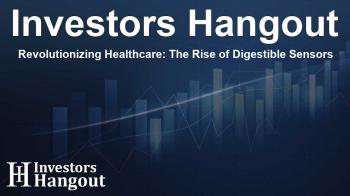Revolutionizing Healthcare: The Rise of Digestible Sensors

Overview of Digestible Sensors Market Growth
The digestible sensors market has gained significant momentum, and its potential is reflected in the anticipated growth projected to reach a remarkable USD 9.56 billion within a few years. This burgeoning market, which started with a valuation of USD 2.31 billion, shows promise in revolutionizing the healthcare and medical technology industry.
Innovation in Patient Monitoring
How Digestible Sensors Work
The concept of digestible sensors introduces a pioneering method where patients can ingest smart pills designed to monitor various physiological parameters from within their digestive tracts. These biocompatible sensors are engineered to send real-time data to healthcare providers, allowing for accurate, non-invasive monitoring. The integration of sensor technology within pills is reshaping patient care, particularly for chronic conditions and during clinical trials.
Benefits of Smart Pills
One of the key advantages of these edible sensors is their ability to measure crucial health indicators, such as temperature and acidity levels, directly from the digestive system. For patients requiring constant medical care, such as those with diabetes or gastrointestinal disorders, these sensors provide invaluable real-time monitoring, enabling timely interventions and better management of their health conditions.
Market Drivers and Trends
Increasing Demand for Chronic Disease Management
The surge in chronic diseases globally, including diabetes and cardiovascular issues, is a primary driver of the digestible sensors market expansion. The technology addresses the ongoing need for effective, non-invasive methods to monitor patient health continuously. As healthcare professionals seek innovative solutions to manage these conditions, digestible sensors are becoming essential tools in patient monitoring systems.
Advances in Personalized Medicine
The shift towards personalized medicine highlights the need for precise data collection from patients. Digestible sensors play a crucial role in tailoring treatment decisions based on real-time data, improving therapeutic outcomes while minimizing side effects. This aligns with the growing demand for more customized healthcare solutions, ultimately leading to enhanced patient satisfaction and treatment effectiveness.
Integration of Technology in Healthcare
Wearable Technology and Data Connectivity
The evolution of digestible sensors is bolstered by the rise in wearable technology and smartphones. By establishing seamless connectivity between internal sensors and external monitoring devices, patients can now track their health metrics conveniently and intuitively. This integrated approach not only enhances the quality of patient care but also fosters increased engagement between patients and healthcare providers.
Challenges Faced by the Industry
While the digestible sensors market presents several opportunities, it is not without its challenges. The high costs associated with the development and manufacturing of these advanced devices can be prohibitive, particularly for smaller companies. The complexity of ensuring the biocompatibility and safety of these sensors adds to the financial burden. However, as technology matures, these costs are anticipated to decrease, enabling broader market access.
Future Directions and Opportunities
Growth Potential in Emerging Markets
Regions such as Asia-Pacific are expected to witness rapid growth in the digestible sensors segment, fueled by increasing healthcare demands and a rising prevalence of chronic diseases. The adoption of this innovative technology in underserved areas signifies tremendous potential for enhancing health outcomes globally.
Potential Collaborations
Strategic partnerships between technology firms and healthcare providers can pave the way for enhanced innovation in the digestible sensors market. By leveraging the expertise of various stakeholders, this market segment can further expand its applications, leading to more robust healthcare solutions.
Frequently Asked Questions
1. What are digestible sensors?
Digestible sensors are advanced medical devices that can be ingested to monitor various health metrics from within the body, providing real-time data to healthcare providers.
2. What factors are driving the growth of the digestible sensors market?
The growing prevalence of chronic diseases and the demand for personalized medicine and real-time monitoring are major drivers for the digestible sensors market.
3. How does the integration with wearable technology enhance patient care?
Integrating digestible sensors with wearable devices enables continuous health monitoring, allowing healthcare providers to access real-time data effortlessly and improving patient engagement.
4. What challenges does the digestible sensors market face?
High development and manufacturing costs pose significant challenges, particularly for smaller companies aspiring to enter the market.
5. Which region is expected to lead the digestible sensors market?
North America currently leads the market, but the Asia-Pacific region is projected to exhibit the fastest growth due to increasing healthcare needs.
About Investors Hangout
Investors Hangout is a leading online stock forum for financial discussion and learning, offering a wide range of free tools and resources. It draws in traders of all levels, who exchange market knowledge, investigate trading tactics, and keep an eye on industry developments in real time. Featuring financial articles, stock message boards, quotes, charts, company profiles, and live news updates. Through cooperative learning and a wealth of informational resources, it helps users from novices creating their first portfolios to experts honing their techniques. Join Investors Hangout today: https://investorshangout.com/
Disclaimer: The content of this article is solely for general informational purposes only; it does not represent legal, financial, or investment advice. Investors Hangout does not offer financial advice; the author is not a licensed financial advisor. Consult a qualified advisor before making any financial or investment decisions based on this article. The author's interpretation of publicly available data shapes the opinions presented here; as a result, they should not be taken as advice to purchase, sell, or hold any securities mentioned or any other investments. The author does not guarantee the accuracy, completeness, or timeliness of any material, providing it "as is." Information and market conditions may change; past performance is not indicative of future outcomes. If any of the material offered here is inaccurate, please contact us for corrections.
